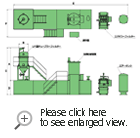- HOME
- Product info
- TYPE-UF TUBULAR FILTER Precoat type
PRODUCTSTYPE-UF TUBULAR FILTER Precoat type
Coolant liquid filter for machine industries
This is a pre-coat type of precision filter used to recycle polishing and grinding liquid in machine industries.
Many of these filters are shipped as part of large-scale concentrated coolant systems capable of performing processes ranging from filtration to final dewatering.
Equipment features

- This precision filter performs pressure filtration by using a filter cloth on which D.E. powder is pre-coated.
From the start of filtration, the filter can capture and separate solid particles in units of microns. - The instantaneous back-pressure washing system can efficiently wash the filter cloth in a very short time.
- The filtration liquid is used for washing filter element.
The filter equipment discharge no washing drainage because it recovered and reuses the back-washed slurry liquid after dewatering. - The filter equipment is constructed to maximize the effective filtration area.
This increases the filtration capacity and enables the filtration of a large amount of raw liquid. - This filtration system features a simple flow of liquid and easy operation, and is thus suited for automation.
Once the system is fully automated, the cost of liquid control can be significantly reduced.
Structure

Operation
- General View
- 1.Precoating Procces
- 2.Filtration Procces
- 3.Backwash Procces
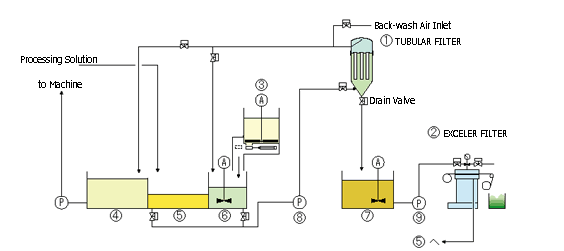
① TUBULAR FILTER ② EXCELER FILTER ③ D.E. Powder Feeder ④ Clean Tank ⑤ Dirty Tank ⑥ Precoat Tank ⑦ Drain Tank ⑧ Filtration Ponp ⑨ Diewatering Pump
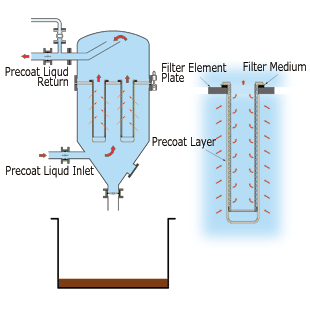
- 1. A preset amount of D.E. powder is fed from the D.E. powder supplying equipment to the precoat tank.
- 2. The pre-coat liquid containing mixed and dispersed D.E. powder is pumped up to the UF type tubular filter by the filtration pump, filtered by the filter cloth, and then returned to the precoat tank.
- 3. This pre-coat operation continues for about 20 minutes.
As a result, a uniform layer of D.E. powder (precoat layer) is formed on the surface of the filter cloth.
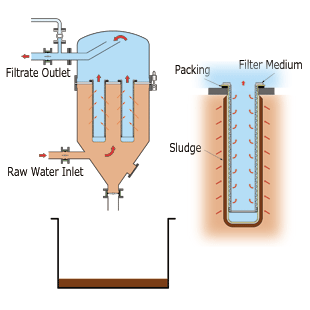
- 4.At the end of the precoating process, the suction pipe of the filtration pump is switched from the precoat tank to the dirty tank.
- 5.Liquid in the dirty tank is pumped to the tubular filter by the filtration pump, pressure-filtered through the pre-coat layer, and then sent to the clean tank.
Filtration through the pre-coat layer can help keep the filter cloth clean and achieve high filtration accuracy from the start of filtration. - 6.Filtration lasts about 10 hours, depending on the quantity of liquid.
The filtration process ends at filtration timer activation or when the backwash button is pressed.
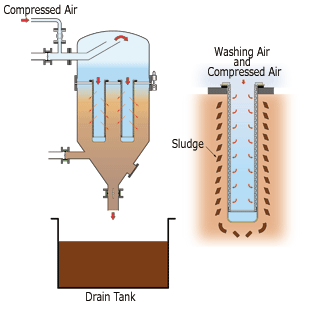
- 7.At the end of the filtration process, all automatic valves close and the filtration pump stops.
- 8.The backwash air valve then opens to compressed air into the filter body.
The compressed air expels filtration liquid on the filter top via blasts from inside to outside of the filter cloth, in order to clean it.
The backwash liquid used for washing is discharged into the drain tank. - 9.The backwash liquid discharged into the drain tank is filtered and dewatered by the EXCELER FILTER.
The filtrate is sent to the dirty tank and recycled.
The dewatered solid contents are discharged to the outside. - 10.At the end of backwashing and draining, the filter equipment returns to the first filtration process and restarts from the precoat process.
Use
- Machine industries…
Various kinds of coolant liquid for ultra-hard polishing and silicon grinding. - Wastewater treatment…
Recycling of semiconductor washing liquid and purification of various drainage.
Major items
| TYPE (□Part Material symbol) |
UF-45□ | UF-55□ | UF-65□ | UF-75□ | UF-90□ | UF-105□ | UF-120□ | UF-120H□ |
|---|---|---|---|---|---|---|---|---|
| TUBULAR FILTER Filtration area(m2) |
2.4 | 3.6 | 4.8 | 7.2 | 10.8 | 15.2 | 20 | 25 |
| A(㎜) | 2500 | 2850 | 3100 | 3250 | 3400 | 3500 | 3750 | 4000 |
| B(㎜) | 450 | 550 | 650 | 750 | 900 | 1050 | 1200 | 1200 |
| C(㎜) | 4000 | 4350 | 4600 | 4950 | 5300 | 5400 | 5750 | 6000 |
| D(㎜) | 1500 | 1500 | 1500 | 1700 | 1900 | 1900 | 2000 | 2000 |
| E(㎜) | 8000 | 8400 | 9500 | 10000 | 11500 | 13200 | 16000 | 18000 |
| F(mm) | 1900 | 2400 | 2700 | 2700 | 2700 | 3000 | 3000 | 3000 |
| AIR TANK(L) | 230 | 400 | 600 | 800 | 1000 | 1500 | 2000 | 2000 |
1) The filtration capacity is not shown here as it depends on the liquid specifications.
2) The required compressed air is 0.45 MPa minimum and 0.2Nm3/min. (ANR).
3) Dimensions C, D, E, and F are for reference only, as said dimensions depend on the quantity of liquid to be filtered and the layout of equipment.
POWDER FEEDER
There are three methods of following a feature Each powder feeder, you can choose the best method for your application.
- Screw conveyor type
- Cup throw-in type
- Rotary valve type
~50kg
Feature
This type uses a screw conveyor provided under the D.E. powder stock tank to convey D.E. powder to the liquid tank as it revolves.。
The D.E. powder feed rate can be easily changed by adjusting the timing of screw conveyor revolutions.
This screw conveyor type is available when a relatively small or exact amount of D.E. powder is fed.
~100kg
Feature
This type uses a cup provided on the bottom of the stock tank, puts a preset amount of D.E. powder in the cup while stirring D.E. powder in the tank, drives the cup via a mini air cylinder towards the opening on top of the liquid tank, and then empties the cup there.
The amount of D.E. powder to be fed can be adjusted by the number of cups, cup sizes, or a combination thereof.
This type is available when a large amount of D.E. powder is to be fed in a short time, but not so exactly.
~200kg
Feature
This type uses the revolutions of a rotary valve provided under the D.E. powder stock tank to feed D.E. powder.
The stock tank is protected against the entry of vapor from the liquid and can store a large amount of D.E. powder (about 200 kg).
The amount of D.E. powder to be fed is determined by the number of valve revolutions.

